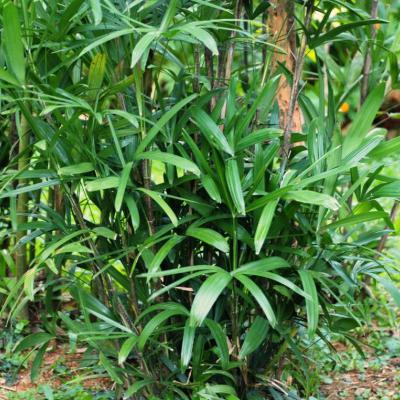Arecaceae-Rhapis-subtilis
Classification
- Botanical Family : Arecaceae
- Genus : Rhapis
- Epithet : subtilis
- German Family Name: Palmgewächse
- English Name: Dwarf Thailand Lady Palm
- Thai Name: จั๋งนิ้วมือ
- Thai Phonetic: jang new moue
- Author: Becc.
- Height: 1.50
Water Requirements
Plant Type
Light Requirements
Cultivation
The name Rhapis comes from the Greek and means needle, which points to the most long segments of the leaves, because of the deep cuts in the leaf that looks such as needles. The species name subtilis means fine, thin, slim.
Rhapis subtilis is a small evergreen palm, which is rarely larger than 1.50 m high. It has many thin, bamboo-like stems that grow from the underground rhizome (root) and give the palm the appearance of a bush. Each stems developed at the end several leaves, which are divided into several segments and are fan-like. The leaves are glossy dark green. The small flowers are creamy white and arranged in panicles.
Rhapis subtilis is very easy to maintain. The plant needs a partial shade to shady place, regular watering, but the soil can be dry out between watering. Dead leaves should be removed.
Rhapis subtilis is an ideal planting in beds as well as a pot plant for indoor and outdoor use and looks very nice in front of Rhapis humilis. Rhapis subtilis can also be planted under trees and tolerates the conditions near the sea.
Rhapis subtilis is similar in appearance to Rhapis excelsa, but differs in the number of segments. While Rhapis excelsa has about five to eight segments in the leaves, Rhapis subtilis has only three to six segments.
Propagation: by division of the root ball
Der Name Rhapis kommt aus dem Griechischen und bedeutet Nadel, was wohl auf die langen Segmente der Blätter hinweist, die durch die tiefen Einschnitte im Blatt wie Nadeln aussehen. Der Artname subtilis bedeutet fein, dünn, schlank.
Rhapis subtilis ist eine kleinere immergrüne Palme, die selten größer als 1,50 m hoch wird. Sie hat viele dünne, bambusartige Stämme, die aus dem unterirdischen Rhizom (Wurzel) treiben und der Palme das Aussehen eines Busches verleihen. Jeder Stamm entwickelt an dessen Ende mehrere Blätter, die fächerartig und in mehrere Segmente gegliedert sind. Die Blätter sind glänzend dunkelgrün. Die kleinen Blüten sind creme weiß und in Rispen angeordnet.
Rhapis subtilis ist sehr pflegeleicht. Die Pflanze benötigt einen halbschattigen bis schattigen Platz, regelmäßige Wassergaben, wobei die Erde schon mal abtrocknen kann. Abgestorbene Blätter sollten entfernt werden.
Rhapis subtilis eignet sich hervorragend als Pflanzung in Beeten genau so gut wie als Kübelpflanze für drinnen und draußen und sieht sehr gut im Vordergrund vor Rhapis humilis aus. Rhapis subtilis kann auch unter Bäume gepflanzt werden und kommt sehr gut mit den Bedingungen in Meeresnähe zurecht.
Rhapis subtilis ist in ihrem Aussehen Rhapis excelsa ähnlich, unterscheidet sich jedoch in der Anzahl der Segmente. Während Rhapis excelsa ca. fünf bis acht Segmente in den Blättern hat, kann Rhapis subtilis nur drei bis sechs Segmente aufweisen.
Vermehrung: durch Teilung des Wurzelballens


